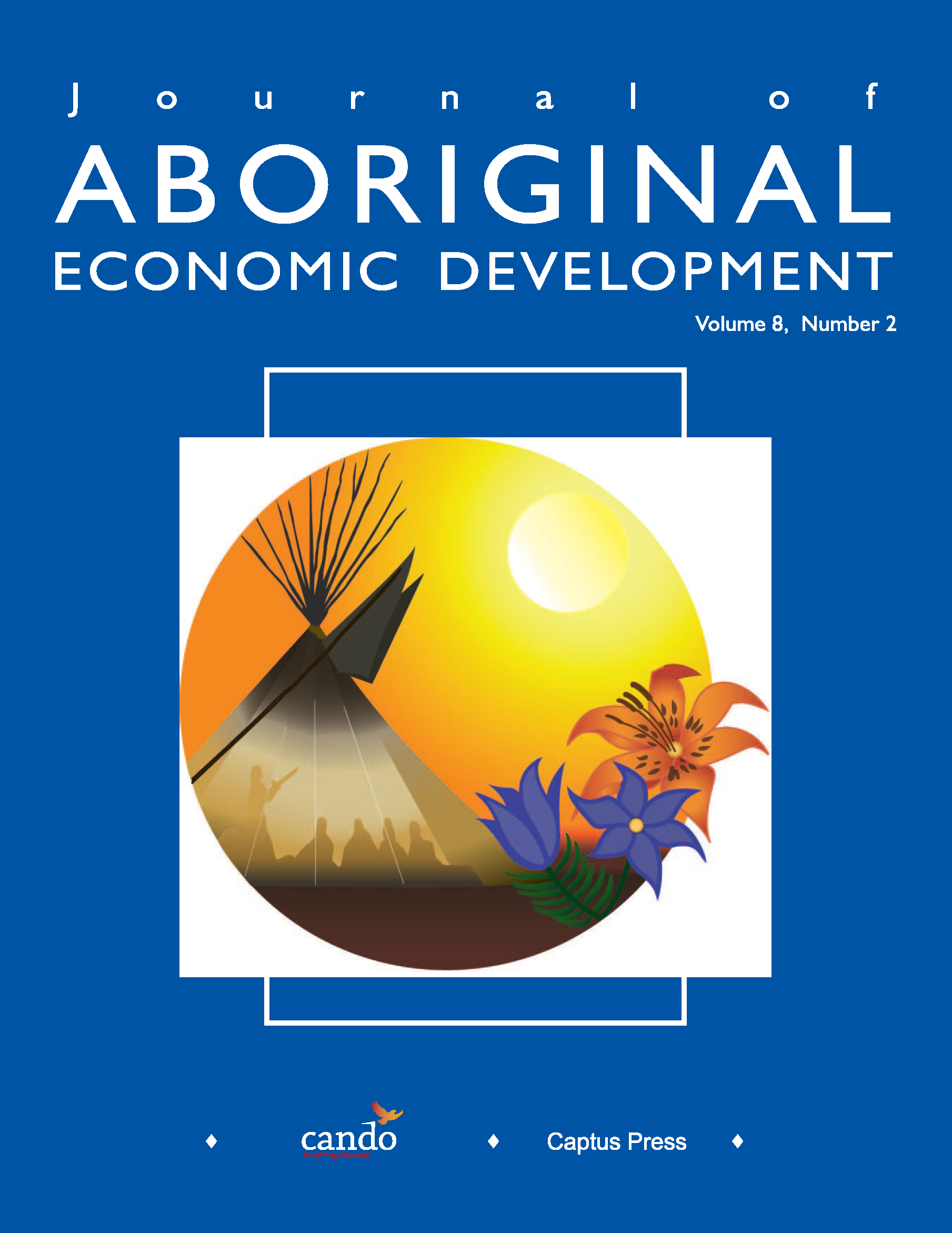Off-Reserve Employment Options For On-Reserve First Nations In Canada
DOI:
https://doi.org/10.29173/jaed324Keywords:
Business And Economics, Commuting, Economic activity, Economic development, Economic opportunities, Economic wellbeing, Education, Employment, Ethnic Interests, Job opportunities, Labor force, Labor market, Land use planning, Migration, Native North Americans, Participation, Population, Population growth, Reserves, Rural areas, Secondary schools, Spillover effect, Urban areas, On-Reserve First Nations in Canada, Indigenous employment, Indigenous economyAbstract
Alternative land management options for First Nations are intended to improve their well-being through on-Reserve economic development. Another means by which First Nations are increasing their participation in the economy is through migration off Reserve, primarily urban centres. A third, to date neglected, means by which First Nations participate in the economy is through accessing off-Reserve employment while retaining Reserve residence. While positive urban agglomeration spillovers in the form of employment opportunities for rural populations are well established for the general population, this has not been investigated for Reserve populations. This paper examines the incidence and determinants of off-Reserve employment by Reserve residents in Canada. We find that along with distance, population growth rates and a higher percentage of the population over the age of 15, out-commuting rates from Reserves are influential in Community Well-Being Scores. Out-commuting is, in turn, facilitated by high school completion rates and negatively affected by distance. We conclude that improved access to off-Reserve employment for Reserve residents is an important means of improving the well-being of Reserve populations, and that a high school education is associated with off-Reserve employment.
Downloads
References
Aboriginal Affairs and Northern Development Canada (AANDC). 2009. Federal Framework for Aboriginal Economic Development. Available at <http://www.aadnc-aandc.gc.ca/eng/1100100033498/1100100033499>. [Accessed May 31, 2013.]
Aboriginal Affairs and Northern Development Canada (AANDC). 2012. Update on the Implementation of the Federal Framework for Aboriginal Economic Development. Available at <http://www.aadnc-aandc.gc.ca/eng/1357225364409/1357226235936>. [Accessed May 31, 2013.]
Ali, Kamar, M. Rose Olfert & Mark D. Partridge. 2011. “Urban Footprints in Rural Canada: Employment Spillovers by City Size”. Regional Studies 45(2): 239–60.
Barkley, D.L., M.S. Henry & S. Bao. 1996. “Identifying ‘Spread’ versus ‘Backwash’ Effects in Regional Economic Areas: A Density Functions Approach”. Land Economics 72(3): 336–57.
Bolton, Roger. 1992. “‘Place Prosperity vs People Prosperity’ Revisited: An Old Issue with a New Angle”. Urban Studies 29(2): 1992 185–203.
Chokie, M., & Mark D. Partridge. 2008. “Low-Income Dynamics in Canadian Communities: A Place-Based Approach”. Growth and Change 39(2): 313–40.
De Silva, A. 1999. “Wage Discrimination against Natives”. Canadian Public Policy 25(1): 66–85.
Drost, H., & J. Richards. 2003. Income On- and Off-Reserve: How Aboriginals Are Faring? Toronto: CD Howe Institute.
Ferguson, Mark, Kamar Ali, M. Rose Olfert & Mark D. Partridge. 2007. “Voting with Their Feet: Jobs Versus Amenities”. Growth and Change 38(1): 77–110.
Florida, Richard, C. Mellander & K. Stolarick. 2008. “Inside the Black Box of Regional Development — Human Capital, the Creative Class and Tolerance”. Journal of Economic Geography 8: 615–49.
George, P., & P. Kuhn. 1994. “The Size and Structure of Native-White Wage Differentials in Canada”. Canadian Journal of Economics 27(1): 20–42.
Glaeser, E.L., J. Kolko & A. Saiz. 2001. “Consumer City”. Journal of Economic Geography 1: 27–50.
Green, M.B., & S.P. Meyer. 1997. “An Overview of Commuting in Canada with Special Emphasis on Rural Commuting and Employment”. Journal of Rural Studies 13: 163–75.
Henry, M.S., D.L. Barkley & S. Bao. 1997. “The Hinterland’s Stake in Metropolitan Growth: Evidence from Selected Southern Regions”. Journal of Regional Science 37(3): 479–501.
Howard, H.A., & C. Proulx (Eds.). 2011. Aboriginal Peoples in Canadian Cities: Transformations and Continuities. Waterloo, ON: Wilfrid Laurier University Press.
Jacobs, Jane. 1969. The Economy of Cities. New York: Random House.
Krugman, P. 1991. “Increasing Returns and Economic Geography”. Journal of Political Economy 99, 483–99.
Mendelson, M. 2006. Aboriginal Peoples and Post-Secondary Education. Toronto: Caledon Institute.
Norris, M.J., & S. Clatworthy. 2010. “Urbanization and Migration Patterns of Aboriginal Populations in Canada: A Half Century Review (1951–2006)”. Based on Presentation at Indigenous Urbanization in International Perspectives, Saskatoon, SK, October 29–30, 2009.
Olfert, M.R., M. Partridge, J. Berdegue, J. Escobal, B. Jara & F. Modrego. Forthcoming. “Places for Place-Based Policies”. Development Policy Review.
Parr, John B. 1999. “Growth-Pole Strategies in Regional Economic Planning: A Retrospective View”. Urban Studies 36(8): 1247–68.
Partridge, M.D., M.R. Olfert & A. Alasia. 2007a. “Canadian Cities as Regional Engines of Growth: Agglomeration or Amenities”. Canadian Journal of Economics 40(1): 39–68.
Partridge, M.D., R. Bollman, M.R. Olfert & A. Alasia. 2007b. “Riding the Wave of Urban Growth in the Countryside: Spread, Backwash, or Stagnation”. Land Economics 83: 128–52
Partridge, Mark D., & Dan S. Rickman. 2008. “Place-Based Policy and Rural Poverty: Insights from the Urban Spatial Mismatch Literature”. Cambridge Journal of Regions, Economy and Society 1: 131–56.
Partridge, M.D., Md Kamar Ali & M. Rose Olfert. 2010. “Rural-to-Urban Commuting: Three Degrees of Integration”. Growth and Change 41(2): 303–35.
Patrinos, H., & C. Sakellariou. 1992. “North American Indians in the Canadian Labour Market: A Decomposition of Wage Differentials”. Economics of Education Review 11(3): 257–66.
Pendakur, Krishna, & Ravi Pendakur. 2011. “Aboriginal Income Disparity in Canada”. Canadian Public Policy 37(1): 61–83.
Pendakur, K., & R. Pendakur. 2007. “Minority Earnings across the Distribution”. Canadian Public Policy 33(1): 41–62.
Pendakur, K., & R. Pendakur. 2002. “Colour My World: Has the Minority–Majority Earnings Gap Changed over Time?” Canadian Public Policy 28(4): 489–512.
Pendakur, K., & R. Pendakur. 1998. “The Colour of Money: Earnings Differentials across Ethnic Groups in Canada”. Canadian Journal of Economics 31(3): 518–48.
Renkow, M., & D. Hoover. 2000. “Commuting, Migration, and Rural–Urban Population Dynamics”. Journal of Regional Science 40(2): 261–87.
Richards, John G., Aiden R. Vining & David L. Weimer. 2010. “Aboriginal Performance on Standardized Tests: Evidence and Analysis from Provincial Schools in British Columbia”. Policy Studies Journal 38(1): 47–67.
Richards, J. 2006. Aboriginal Policy: Creating Choices. Toronto: CD Howe Institute.
Richards, J., & A. Vining. 2004. “Aboriginal off-Reserve Education”. C.D. Howe Institute Commentary, No. 198.
Sharpe, A., J. Arsenault, S. Lapointe & F. Cowan. 2009. The Effect of Increasing Aboriginal Educational Attainment on the Labour Force, output and the Fiscal Balance. Ottawa: Centre for the Study of Living Standards.
Statistics Canada. 2006. Labour Force. Available at <http://www.statcan.gc.ca/pub/81-004-x/def/4153361-eng.htm>. [Accessed June 21, 2013.]
Statistics Canada. 2009. Percentage of First Nations people living on and off reserve, Canada, 1996 and 2006. Available at <http://www12.statcan.ca/census-recensement/2006/as-sa/97-558/figures/c7-eng.cfm>. [Accessed June 21, 2013.]
Thorsen, Inge, & Jens Petter Gitlesen. 1998. “Empirical Evaluation of Alternative Model Specifications to Predict Commuting Flows”. Journal of Regional Science 38(2): 273–92.
Ubøe, Jan. 2004. “Aggregation of Gravity Models for Journeys to Work”. Environment and Planning A 36: 715–29.
World Bank. 2009. World Development Report Reshaping Economic Geography. Washington, DC: The World Bank.
Downloads
Published
Issue
Section
License
Copyright (c) 2013 Cando

This work is licensed under a Creative Commons Attribution-NonCommercial-NoDerivatives 4.0 International License.




